ARTICLE AD
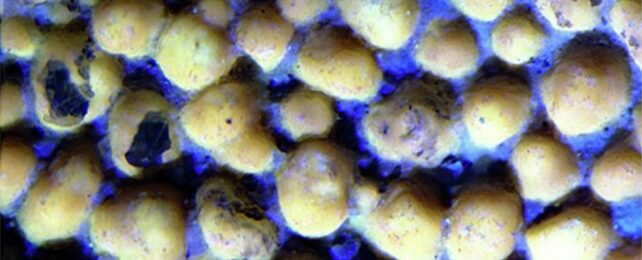 Cross section of dinosaur eggshell under light microscopy. (Siatta et al., Geochimica et Cosmochimica Acta, 2024)
Cross section of dinosaur eggshell under light microscopy. (Siatta et al., Geochimica et Cosmochimica Acta, 2024)
As a scientist, lab work can sometimes get monotonous. But in 2017, while a Ph.D. student of paleobiology at the University of Bristol in the UK, I heard a gleeful exclamation from across the room.
Kirsty Penkman, head of the North East Amino Acid Racemization lab at the University of York, had just read the data printed off the chromatograms and was practically jumping up and down.
The instrument had detected telltale signatures of ancient amino acids in eggshell. Amino acids are the building blocks that make up protein sequences in living organisms.
But this wasn't just any eggshell; it was a fossil from a titanosaur, a giant herbivorous dinosaur that lived about 70 million years ago.
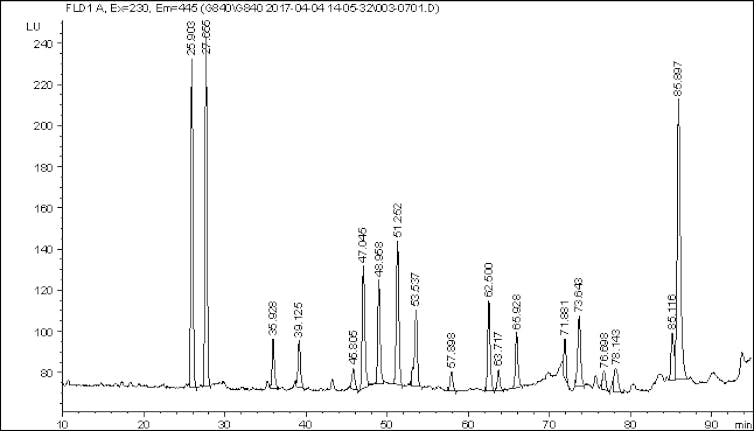 The chromatograph printout that Kirsty Penkman saw. Each peak represents an amino acid detected by the instrument during the analysis. (Evan Saitta)
The chromatograph printout that Kirsty Penkman saw. Each peak represents an amino acid detected by the instrument during the analysis. (Evan Saitta)Not much organic material survives over millions of years, which limits scientists' ability to study the biology of extinct organisms compared to modern ones, whose proteins and DNA can be sequenced. As Penkman's enthusiasm suggested, these amino acids were extraordinary.
In fact, this result came unexpectedly amid our team's efforts to test claims of near-pristine protein preservation in dinosaur bone. I had brought various fossil bones to Penkman, but the results suggested no original amino acids had been preserved, and that they were even contaminated by microbes from the environment they'd been buried in.
Testing eggshell fossils was not even in our original research plan.
Orphan fossil fragments
However, I had just seen that my colleague Beatrice Demarchi, Penkman and their team had detected short protein sequences in 3.8-million-year-old bird eggshell. I predicted that if dinosaur eggshells didn't preserve any original proteins, then their bones likely wouldn't preserve any either, and wanted to see whether that was the case. Luckily, we had a source of dinosaur eggshell.
Around 2000, many eggshell fragments were illegally exported from Argentina into the commercial market. As a fossil-obsessed child, I was even gifted a coin-sized fragment from a US mineral store. Penkman and I tested that fragment, as well as another fragment from a European museum's gift shop.
These fossil fragments in some ways gained scientific value because they didn't belong to any museum collections. We didn't have to worry about damaging them during the analysis. To our surprise, we had stumbled upon a rare opportunity to study ancient organic remains from a dinosaur.
Amino acids in eggshell
Prompted by this initial discovery, our large, international team analyzed more dinosaur eggshells from Argentina, Spain and China, using a wide variety of techniques.
Although some eggshells preserved amino acids far better than others, the evidence overall suggested that these molecules were ancient and original, possibly ranging from 66 million to 86 million years old.
During life, proteins that helped to calcify the eggshell became trapped within the mineral crystals. The remaining amino acids we detected, however, consisted of free molecules that had broken off from their protein chains by reactions with water. We only detected a few of the most stable amino acids. Less stable ones were absent, as they had degraded away.
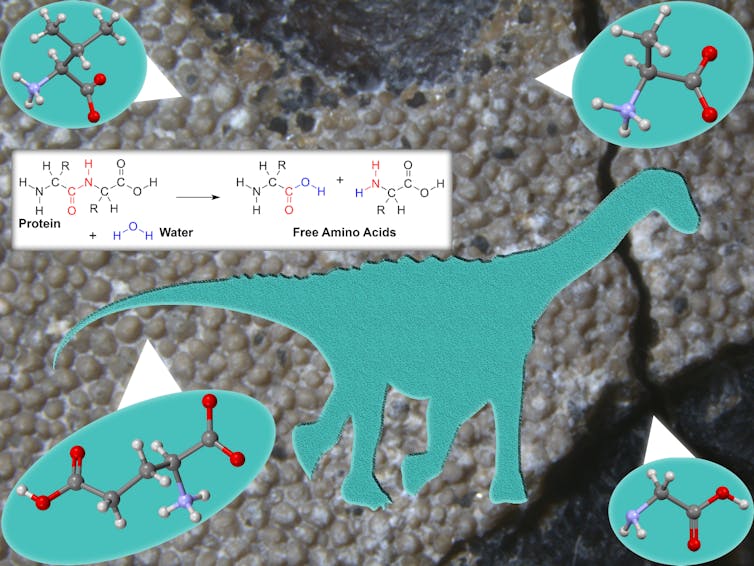 A titanosaur, models of the four preserved amino acids, and the breakdown reaction from a protein sequence into free amino acids. (Arthur S. Brum (silhouette), Ben Mills (ball-and-stick models), V8rik (hydrolysis reaction))
A titanosaur, models of the four preserved amino acids, and the breakdown reaction from a protein sequence into free amino acids. (Arthur S. Brum (silhouette), Ben Mills (ball-and-stick models), V8rik (hydrolysis reaction))The amino acids still preserved were what chemists call racemic. Amino acids can occur in left- or right-handed configurations. Living organisms regulate their amino acids such that they appear almost exclusively in the left-handed configuration. After the organism dies, amino acids can convert between handedness until they reach 50-50 mixtures of both configurations.
A 50-50 mix is known as racemic and suggests that the amino acids had separated from their protein chains very long ago.
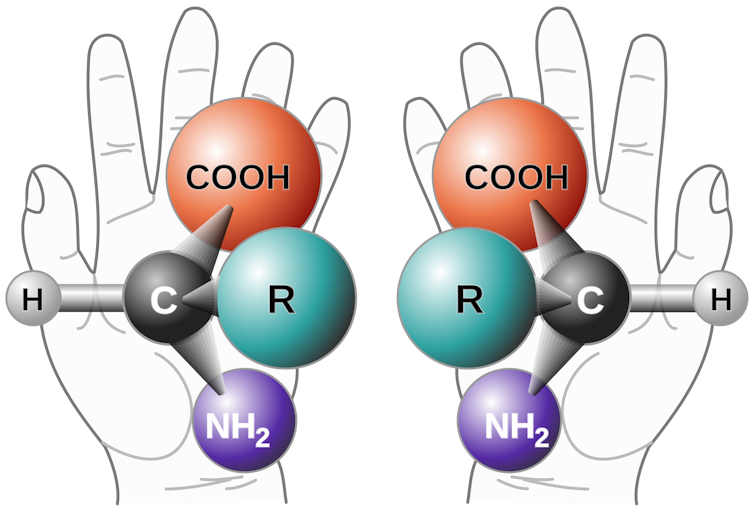 Left- and right-handed versions of amino acids. While so-called stereoisomers have the same chemical formula, they're organized as mirror images of each other. (NASA)
Left- and right-handed versions of amino acids. While so-called stereoisomers have the same chemical formula, they're organized as mirror images of each other. (NASA)Calcite, an amino acid archive
Our dinosaur eggshell results showed more extreme degradation than seen in younger fossils of bird eggshell and mollusk shell. Our results also matched those from experiments that expose eggshell to heat in the lab, simulating degradation over thousands or millions of years.
Organisms reinforce these shells with a type of calcium carbonate mineral called calcite. Unlike the calcium phosphate that makes up bone, calcite can act as a closed system by trapping the products of proteins involved in calcification as they break down, including free amino acids separated from protein sequences. This closed system allowed us to observe the amino acids in our analyses.
Bird eggshell is even among the best materials to find preserved protein sequences in fossils, let alone free amino acids. Demarchi's team has detected short, intact sequences of amino acids still bound in a chain from bird eggshell at least 6.5 million years old.
Other researchers have claimed to have found more ancient amino acids, as well as more extreme and less likely claims of preserved protein sequences. But, our study uses a wider range of methods and reports the best signal for stable molecules in a tissue we now know preserves molecules well.
Our dinosaur amino acids might hold the record for the oldest protein-related material yet found for which the evidence is very strong, and the first clear evidence from a Mesozoic dinosaur.
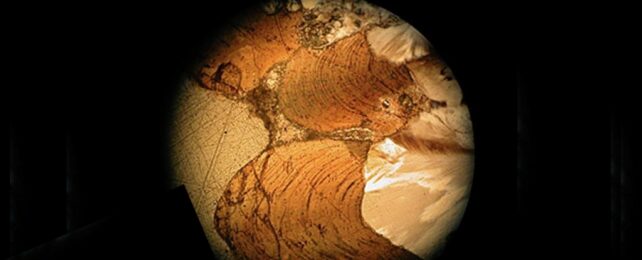 Dinosaur eggshell under light microscopy. (Siatta et al., Geochimica et Cosmochimica Acta, 2024)
Dinosaur eggshell under light microscopy. (Siatta et al., Geochimica et Cosmochimica Acta, 2024)Using calcite to look back in time
The genetic sequence in DNA that is ultimately expressed in proteins provides a source code for organisms that scientists can study. But if only a subset of amino acids are preserved in the fossil, it's like removing all but five letters from a book – little literary analysis is possible. So, what messages from ancient life might persist in these calcite time capsules?
One biologically informative signal might involve stable isotopes, which are atoms of the same element with different masses. Scientists can look at the stable isotope ratios of carbon, oxygen or nitrogen to learn about their source, such as the animal's diet. Since eggshell calcite is a closed system, stable isotope ratios in their amino acids are more likely to come directly from the dinosaur, rather than outside contamination.
In future research, our team will use fossils to search even further back in time. Organisms other than egg-laying dinosaurs reinforced their tissues with calcite. For example, marine arthropods called trilobites that lived more than half a billion years ago had calcite in their eyes.
Studying older remains could help scientists understand the molecular changes that happen in fossils over long periods of time. Fossil calcite, Earth's molecular time capsule, may send faint tales from long-gone life for researchers to better understand their biology.
The orphan eggshells used in our initial analysis found a happy ending. They eventually gained a new home at Argentina's Museo Provincial Patagonico de Ciencias Naturales, a natural sciences museum in Patagonia, repatriated to the only province known to produce that type of eggshell microscopic structure.![]()
Evan Thomas Saitta, Postdoctoral Scholar in Paleontology, University of Chicago
This article is republished from The Conversation under a Creative Commons license. Read the original article.

 8 months ago
40
8 months ago
40 

